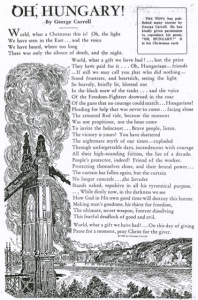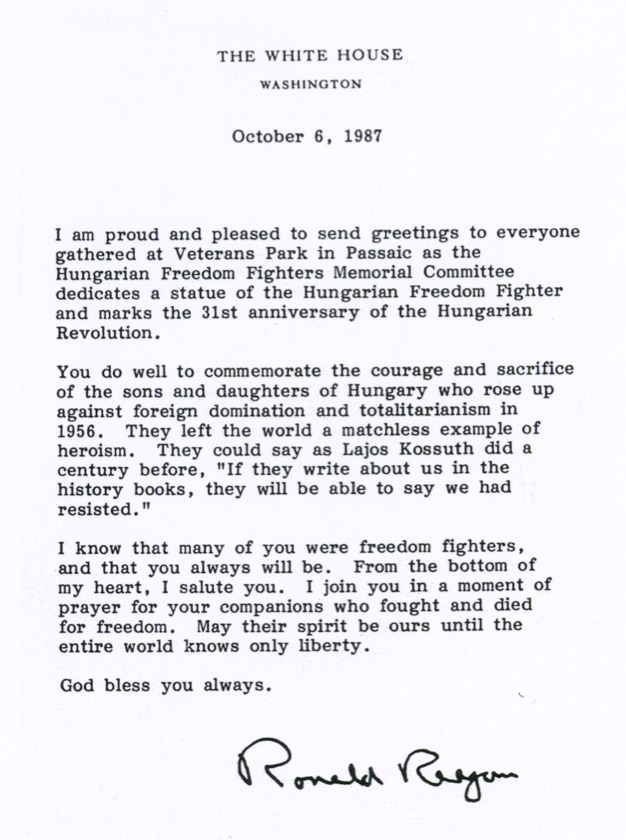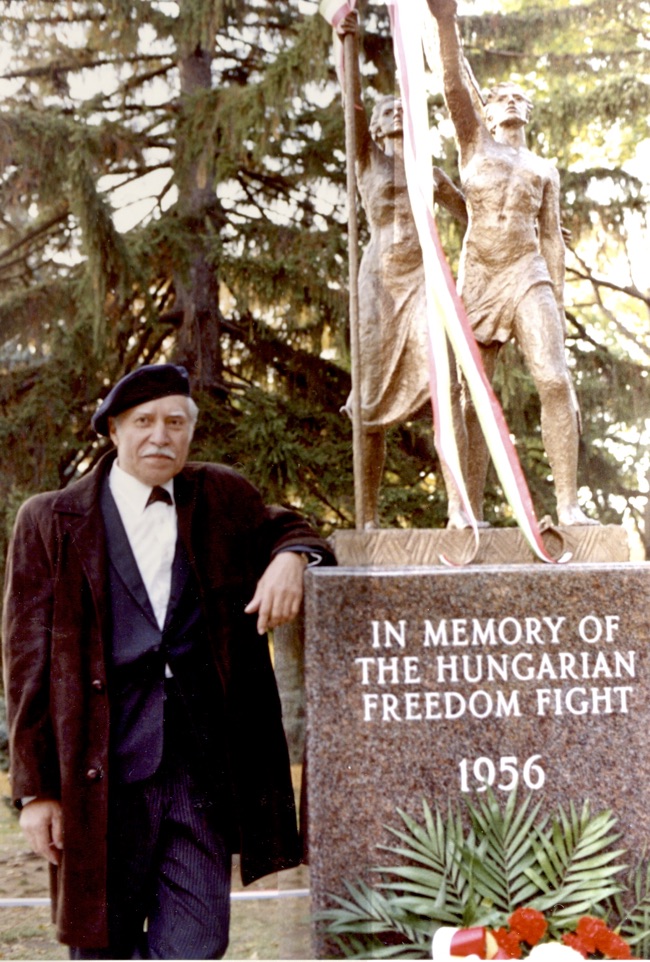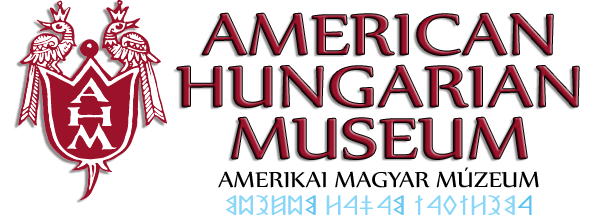1956
After November 4 in Passaic
Dear Reader,
The year 2006 is a momentous year for the Hungarian Nation and for all Hungarians around the world who are not living inside the political borders of Hungary. It is the 50th Anniversary of the glorious, but brutally repressed 1956 Freedom Fight. Hungarians forever will be remembered as the first people to show the world that the Soviet Tyranny is vulnerable. The history of the 1956 Uprising is well known to all educated persons, and this year it became evident that this event is singularly important to all civilizations of the free world. Hundreds of articles in numerous languages and remembrances in many countries attest to this fact. The Freedom Fight of 1956 in Hungary has justly taken its historical place.
The Mission of the American Hungarian Museum, Passaic is to make Hungarian culture and history available to the general public in Northern New Jersey and to support and document locally Hungarian life and history. New Jersey has always been an important place for immigrant groups due to its vibrant industry; it also offered jobs and existence to thousands of Hungarian immigrants from the turn of the 20th Century. After the 1956 Revolution, when 200,000 Hungarians escaped from the Communist Regime, many of those persons and families found opportunities in Passaic area. Who were these immigrants and what happened to them? This booklet begins to provide answers to these questions. The book only offers a slim cross section of the post-1956 immigration and we publish it in the hope that in the future researchers may use it as a starting point to undertake a more detailed study of our Hungarian enclave.
The history of the Hungarian Revolution in this book is presented from local approach; we would like to document how the historical event was observed on the Passaic community level, by Hungarian and non-Hungarian alike. The events touched the lives of many – this book may offer a glimpse into these emotional times. We also include names and brief biographies of some of the individuals who joined the Northern New Jersey Hungarian community in 1956. (Only in the Hungarian language edition. Ed.) They arrived here by the hundreds, and in those years the “melting pot” absorbed them fast, and they became part of the ethnically diverse fabric of the American culture. Many never participated in Hungarian community life and perhaps only their name or accent reveal that they arrived from Hungary. In our book, we attempted to record the names of some who wished to participate and who voluntarily offered to be remembered for future generations that their impact on American life was the result of the events in Hungary which shocked the world 50 years ago. Many of these individuals did not participate actively in the Revolution – but they were called to task one they arrived here and shared their stories about the Communist dictator ship to all those who were interested. They, by maintaining their Hungarian identity, contributed to the positive outcome of the Uprising and have also carried the flame of all those Hungarians who stood up for freedom in 1956 and fought against oppression.
We hope this book will allow you to an intimate view of events which occurred 50 years ago in our Northern New Jersey Hungarian Community.
Kálmán Magyar

OH, HUNGARY!
1956 IN PASSAIC, NEW JERSEY
… The Hungarian Revolution of October 23, 1956 marked a turning point in the life of most Hungarians living in Hungary or in the United States. Tens of thousands of refugees left their homeland an found a new home in Western Europe and in the United States. Most of these immigrants were very different from those who came at the turn of the century. These new immigrants were political refugees and did not plan to return to the Communist world left behind.
Our church immediately organized to help the newly arriving refugees. We rented an entire apartment house on Gregory Avenue in Passaic to help provide a place for them to stay. By the end of December, 1956, more than $4,000 was raised for their benefit. Rev. Bertalan and several members of our congregation were finding jobs and apartments for many of them. Our church opened its heart to the Hungarian refugees and welcomed them among our congregation. Eventually, our church helped 106 Hungarian refugees, who arrived form December 1956 to December 1957.
(Endre Krajcsovics, The Centennial Jubilee and History of the Hungarian Reformed Church,
Passaic, New Jersey, 1995)
* * *
… World War II took its toll on Hungary and all of Europe. Many of the young men of St. Stephen’s went off to war and never returned. Then, in October 1956, revolution broke out on the streets of Budapest when protesters of all ages stood up to the Communist regime, which governed Hungary at the behest of the Soviet Union. Both of these tragedies brought many young Hungarians and their families to Passaic to join the ranks of St. Stephen’s Church. The parish received more than 120 refugee families after the revolution, an event that stirred Hungarian-Americans and prompted them to new acts of charity. Therefore, this new generation of Hungarian families found not only a warm welcome from Father Gáspár, but also more often than not, the comforting words, „What can we do for you? If you need anything, please ask.” Together with the Hungarian Reformed Church and its pastor, Rev. Imre Bertalan, St. Stephen’s helped these families establish new lives.
… In 1957, at Christmas St. Stephen celebrated the dedication of the Liberty Bell to commemorate the Freedom Fight of October 23, 1956.
(St. Stephen’s R.C. Magyar Church, Passaic, NJ Celebrating the 100th Anniversary of Our Church, 2003)
* * *
In 1958, on October 19th, the Hungarians of Passaic commemorated the Revolution and Freedom Fight of 1956 in an especially solemn way. It happened for the first time that all the churches and organizations and clubs of the area celebrated together with a rich program. Well-known personalities were invited. The distributed program included the following text:
WHY WE CELEBRATE…?
Two years have gone by since the Hungarian Revolution of Oct. 23. 1956 shaking the conscience of the whole world. No event during the twelve years of the cold War had more far reaching consequences than the heroic struggle of those handful men and women in that small country some, 4,000 miles away from us.
Since then the European Communist parties as well as their American counterpart have gone broke. People left the communist ranks by the thousands, famous leaders and individuals like Picasso, turned suddenly their back to the Moscow leadership uncommitted countries drew to the West because of the Hungarians fate. Red infiltration stopped suddenly among intellectuals and workers as well because the Soviet imperialistic aims were blanked without a shadow of doubt.
That is why we feel the second anniversary of the Revolution is not an intern affair of Hungarians, but it is a day to remember for all mankind. The American Hungarian Community of Northern New Jersey in cooperation with all Freedom-Fighters resettled in this area, are opening the doors wide open, inviting every American to their commemorating celebration, which should be everyones celebration.
On Sunday October 19, 1958 at 3. P.M. they will have a Commemoration Rally, at the Auditorium of the St. Stephen’s Church 215. Third Street, Passaic, New Jersey.
Governor Robert B. Meyner the first civilian host to all 38 thousand Hungarian Freedom-Fighters, who took refuge in the United States, is invited as the main speaker of the event. Mr. De Mauro the Mayor of Passaic will speak on behalf of the communities giving home to the new comers. Father Vazul Végvári, President of the Freedom-Fighters Federation, and Dr. Gábor De Bessennyey, Washington D.C., President of the American Friends of Antibolshevic Block of Nations will address the rally in Hungarian and English.
George Hajdu, President of the American Hungarian Federation will introduce the Governor of our State to the rally.
A film strip taken in Budapest in 1956 by the CBS Studios, will show the terrible fightings in their naked reality. Tibor Tollas the famous poet of the Revolution will give samples of his poems written in prison (also in English). Choir recitation and Hungarian Boy and Girl Scouts will complete the program.
The rally is sponsored by the American Hungarian Churches in Passaic, in cooperation with all Hungarian Clubs and Organizations of the neighbor hood.
HUNGARIAN FREEDOM FIGHTERS
MEMORIAL In Passaic, NJ
In 1986, approaching the 30th Anniversary of the Hungarian Revolution and Freedom Fight, a group of Hungarians were discussing the upcoming ceremonies. At that time, Mr. Ernő Balogh was the president of the American Hungarian Citizens League in Garfield.
His longtime dream was to erect a suitable memorial for those who gave their lives for this noble cause. When he suggested this idea to the fellow members at the club, within minutes $3,000 was raised to begin work on erecting a statue in Passaic Park. The City of Passaic welcomed the idea and the ground braking ceremony took place in October of 1986. The location of future construction was marked with the American and Hungarian flags side by side and array of beautiful flowers.
The plans of the memorial found great approval by the city, therefore a more prominent area was designated in Third Ward Park. Due to the untiring efforts of Mr. Balogh, the enthusiasm grew so rapidly, that the Freedom Fighter Memorial – by sculptor Csaba Kúr – could be erected and dedicated at a glorious ceremony on October 25, 1987. President Ronald Reagan sent greetings to everyone gathered at the Park in Passaic for the dedication of the Freedom Fighters Memorial.


